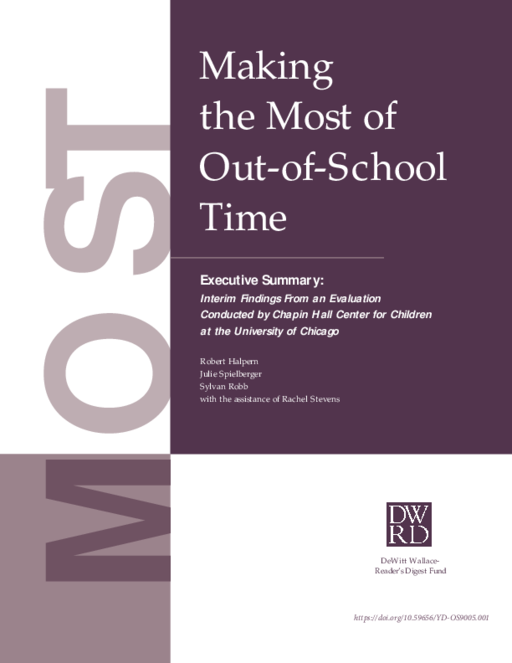Breadcrumb
- Wallace
- Reports
- Making The Most Of Out-Of-School...
Making the Most of Out-of-School Time
- Author(s)
- Robert Halpern, Jullie Spielberger, and Sylvan Robb
- Publisher(s)
- The National Institute on Out-of-School Time at the Wellesley Centers for Women
Summary
How we did this
Through staff interviews, observation of programs, and analysis of quantitative data, researchers at the Chapin Hall Center for Children at the University of Chicago conducted an evaluation of Wallace's Making the Most of Out-of-School Time initiative.
This report shares early lessons from a Wallace-funded initiative to improve the quantity and quality of out-of-school-time programs for families in low-income communities. The effort, called Making the Most of Out-of-School Time (MOST), worked with schools in Boston, Chicago, and Seattle.
Researchers found that MOST had contributed in a variety of ways to the school-age care system in each participating city, including:
- Quantity and quality of care. Researchers saw improvements to the quantity and quality of care for low-income children.
- Collaboration. MOST produced better collaboration among providers.
- Agency-provider relationships. There were stronger relationships between agencies and organizations involved in school-age care.
- New structures and processes. Researchers found that new structures and processes for city-wide systemic activities were created.
Three Elements
Researchers found that out-of-school-time systems should include three elements:
- Providers that offer direct services to children and their families
- Intermediary organizations, such as child care referral agencies and child care advocacy groups, that provide information to parents looking for programs
- City and state agencies that provide funding, licensing, and regulatory oversight.
Other Key Lessons
Improving the quality of school-age care programs is a long-term process. It requires enough resources and technical assistance from outside the program, adequate and stable staff support, and parental involvement. Also, it takes time to form the right team and for a technical assistance provider to develop a trusting relationship with a program and its staff.
Both public and private sector funding are needed. Public sector support is especially critical for low-income families who may otherwise be unable to afford out-of-school-time programs. Private funding can encourage public agencies to put more dollars into school-age care.
Diverse partnerships are of vital importance. They bring together schools, community-based organizations, and others to help communities see new possibilities. They also encourage innovative thinking.
Key Takeaways
- The MOST program contributed to improvements in the quantity and quality of care in afterschool programs.
- In successful out-of-school-time systems, providers offer direct services to children and their families, intermediary organizations provide information to parents, and city and state agencies take care of funding and regulatory oversight.
- Researchers found that improving the quality of out-of-school-time programs is a long-term process.
- Private funding can encourage more support from public agencies.
- Diverse partnerships of schools, community-based organizations and others can engage in innovative thinking.

Although interest in school-age care seems new, it is far from a new phenomenon . . . A century ago settlements were already organizing clubs and classes for the children of immigrants . . .
What We Don't Know
What was the role of private schools, family day care providers, libraries, and schools in Boston?
What would be the impact of changing MOST’s focus in larger urban areas to neighborhoods vs. citywide efforts?

